
|
|
Car Help
Muffler Job |
|
Maintained by
suitti@uitti.net,
Stephen Uitti |
I was late leaving work the other day since I had an appointment closer to work than home. In the parking lot there were two guys attempting to change a flat tire. I asked if they had everything they needed. They said that their tire iron didn't fit one of the lug nuts. It appeared that they'd been at it for some time, despite the resources of a cell phone and a second, fully functional vehicle.
I brought my car over and opened my trunk. I pulled my metric high impact socket set from my tool box, and a breaker bar (a long bar that fits the above sockets). I had purchased the metric socket set and breaker bar for one of my own cars about a decade earlier.
Though the 21 mm socket fit most of the nuts on the wheel, the odd duck nut wasn't a good fit for any of the sockets. A trip back to the tool box for the English sockets was required. It turned out to be 13/16ths. Apparently, this lug nut had once been some sort of locking nut, but had been damaged to be just other nut. It was also clearly longer, of different weight, and should have been replaced if only because it probably unbalanced the wheel. When was the last time your tires were spun balanced while on the car? The breaker bar was able to loosen the nuts with comparative ease.
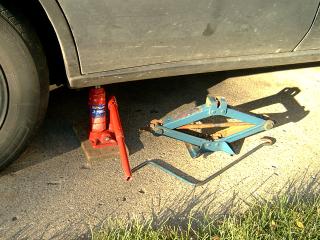 They fitted a scissor jack and cranked it high enough to get the
old wheel off. Then they wheeled the donut spare to the scene.
The car was way too low to get the new tire on, so they cranked
the jack to the top. They did not use my technique of using
the dead tire as a safety under the frame of the car. This
would prevent the car from making it to the ground in the case
of jack failure. However, despite pulling and pushing on the
car using a long lever, the jack didn't fail. At the very
top stretch of the jack, the donut could just barely be put
on the car. It is prudent to carry two jacks, and several
small pieces of wood, so that you can boost the jack an inch (3 cm) or so
to get the car high enough. Two jacks allow one to raise the car
a little so that the other jack can be placed properly with
the wood giving it a higher lift.
It should be noted that not all cars have more than one spot near
each wheel to put a second jack. Don't buy these cars.
They fitted a scissor jack and cranked it high enough to get the
old wheel off. Then they wheeled the donut spare to the scene.
The car was way too low to get the new tire on, so they cranked
the jack to the top. They did not use my technique of using
the dead tire as a safety under the frame of the car. This
would prevent the car from making it to the ground in the case
of jack failure. However, despite pulling and pushing on the
car using a long lever, the jack didn't fail. At the very
top stretch of the jack, the donut could just barely be put
on the car. It is prudent to carry two jacks, and several
small pieces of wood, so that you can boost the jack an inch (3 cm) or so
to get the car high enough. Two jacks allow one to raise the car
a little so that the other jack can be placed properly with
the wood giving it a higher lift.
It should be noted that not all cars have more than one spot near
each wheel to put a second jack. Don't buy these cars.
I say this, but I doubt that I'm competent to judge this while buying cars. No one is. Have you ever asked a sales person a technical question like, hey, can you get two jacks near that left front wheel? I've asked if a car advertised to take regular gas would perform OK on Sunoco's sub-regular. The answer I got was, You could try it - and if it doesn't work, use regular. Of course, I wanted to know before I bought it!
The donut spare tire was tightened onto the car, and the car was lowered without incident. That is, unless you count the fact that the spare really wasn't inflated enough. It might have gotten them to the nearest gas station (a couple miles (a couple km)) where it could be filled properly. It might not. However, my trunk also contains a foot pump, and after five minutes it was inflated enough so that it would make it. It's about ten minutes to fully inflate a regular tire to proper pressure from nearly dead.
The donut spare tire can become non-inflatable. One only finds this out while on the road, at night, around midnight, in winter rain. Fortunately there was a gas station open within a short walk. A can of Fix-A-Flat sealed the leaks and then air could be pumped into it. It was a real relief as it wasn't clear that the foot pump was working.
There are several problems with donuts. One is that they are
not designed to be real tires, just good enough to get you somewhere
where you can get your dead tire fixed or replaced. You are
only supposed to go 50 miles (100 km) or so on them, and then
only at reduced highway speeds - 55 mph (100 kph) or so. If you
have a high vehicle load - say it's full of junk and you are towing
a boat - you'll have to leave the boat behind. Maybe even all your
stuff. Maybe your passengers. If you are further
than 50 miles (100 km) or so, you may be SOL (... Out of Luck).
And then, you'll have to get your dead tire fixed, and (more work)
put the new one back on the car. You've just used up the life of
the donut, so, you'll need another one. On top of that - your big
trips where these things happen are on the weekend. So, lots of
luck finding someone open on Sunday to do all this for you.
Consider getting work where you work Saturdays and Sundays, so
you can do all your trips during the week. Cough, cough.
Donuts are supposed to save the car manufacturer money. However,
they don't save you anything. Each time you need to use
it, you need to change tires at least twice, rather than once.
The chances you'll need it are higher, and the chances that it
will fail miserably are also higher.
Another problem with donut spares is that no one inspects them. To do
that properly, you really have to put it on a car and drive it a block
or so, about once a year. Right. After about six or eight years -
it's dead, but it doesn't look like it. So, you'd better have a cell
phone so you can call a tow truck when (not if) you have a flat.
While you're at it, you'd better budget two extra hours to get
anywhere so that you aren't late. The tow trucks can take quite
awhile to arrive. You do have a credit card, right? With a real
spare tire, you can rotate it into production use, using a known good
tire as a spare. People really do rotate tires - even if they have
someone else do it, and even if they don't do it all that often.
Still, it's prudent to have a pump to bring your spare's pressure up
to standards.
These guys seemed to be very impressed that I had all this stuff, and
was prepared for everything. It isn't that I'm so smart, or with such
wise foresight. It's entirely that I've been burned with experience.
It's hindsight. Hindsight can be 20:20, but it often isn't. I'm an
engineer by training. One might expect
that to give me an edge. It doesn't. These guys are engineers. They
just haven't experienced enough real life. They have cell phones, and
are therefore invincible. But they can still be
inconvenienced. The real problem is that life in America requires a
car. People have to pass tests to get a drivers license. However,
they are essentially incompetent to get where they are going reliably.
It can be argued that the auto industry - the car makers, the
mechanics, the road side assistants, even driver's education go out of
their way to keep up this status quo. Even the police are only
batting about .500 with me. The car makers supply us with donut spare
tires. The mechanics put tires on in a way that we can't take them
off. Tow trucks never, ever, explain what could have been done in
prevention. My driver's education class not only did not teach how to
change a tire, it actually discouraged students from performing any
kind of maintenance of any kind. Their take on it was that it can be
dangerous to drive a car maintained by an incompetent. They didn't
say that you are incompetent. They didn't say that you could never be
competent. It was implicitly assumed. It's probably then mostly a
self-fulfilling prophecy. The police often just want your dead
vehicle off the road, as it might be a danger to others, even when it
isn't. Feh. It adds up to a conspiracy. Each player has their own
incentives and keeps up their end. It makes me ashamed
of working
for car
companies. After all, I want to be
one of the good guys. I want to be proud of myself.
Yeah. And you thought this was about cars.
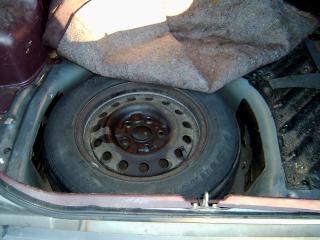 My first attempt to use my donut spare when my car was
about eight years old. Once it was on the car, it lasted about
30 feet (10 m). It didn't just go flat. The tire came completely
off the rim. It can't be pumped up from there. So now there are
two flat tires. Fortunately, this was about 100 yards (100 m)
from my house, and there was a functional car in the garage. Rather
than fix the tire and donut, two new tires and a real rim were purchased.
What I mean by a real rim is one that works exactly like the other
rims on the car. One of my former cars had a spare tire, but the
rim would not accept a hub cap. You can drive on it indefinitely,
but you do not rotate the spare tire when you (or someone
working on your behalf) rotates your tires. It remains untested.
My car has a wheel well in the trunk that is big enough for a real wheel.
Don't purchase a car that does not have enough space for a real spare tire.
My first attempt to use my donut spare when my car was
about eight years old. Once it was on the car, it lasted about
30 feet (10 m). It didn't just go flat. The tire came completely
off the rim. It can't be pumped up from there. So now there are
two flat tires. Fortunately, this was about 100 yards (100 m)
from my house, and there was a functional car in the garage. Rather
than fix the tire and donut, two new tires and a real rim were purchased.
What I mean by a real rim is one that works exactly like the other
rims on the car. One of my former cars had a spare tire, but the
rim would not accept a hub cap. You can drive on it indefinitely,
but you do not rotate the spare tire when you (or someone
working on your behalf) rotates your tires. It remains untested.
My car has a wheel well in the trunk that is big enough for a real wheel.
Don't purchase a car that does not have enough space for a real spare tire.
To be perfectly fair, when talking to a senior engineer at one
car company about ideas on
how to achieve better fuel economy got some unexpected attention.
One aspect argued for two engines.
One was your typical overpowered fuel sucking beast, like a
hemi, and the
other could efficiently deliver power required for cruising down the highway.
It would likely be tiny, perhaps 15 kw (20 horsepower).
The transmission would be electric, with redundancy allowing
either or both engines to power all wheels. I argued that 6%
loss could be achieved, compared with worse than 10% for a differential,
and more for the gears, and more for an automatic.
And, there wouldn't be any engine drag. And, there would be no gears
to shift, or unexpected jerks when it decided to shift, and yet
it would still deliver more power to the road than a manual for
a given engine. What caught the engineer's imagination was that if an engine
died, you'd be able to get home on the other one - even if it was
the tiny one. This, despite the fact that modern automotive engines
are incredibly reliable, and tend not to strand you like running out
of gas or having a flat. Yet this company sells cars that automatically
turn things off when the battery drains to half - rather than cars
that switch things off when you take the key out of the ignition.
Am I a control freak if I think that I should decide when to
drain the battery rather than the car? As far as I can tell, my
position is, why use a complicated mechanism when a simple one solves
the problem completely? Complicated mechanisms break.
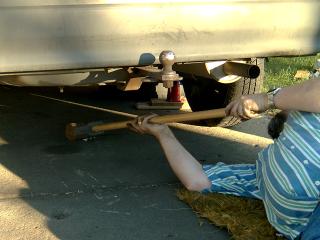 I didn't show these guys my 16 pound (7 kg) sledgehammer. They didn't
need it. Sometimes a tire rim is rusted onto the axle. A
sledgehammer can help to get it off. It entails swinging a
sledgehammer under a car that is propped up on a spindly jack.
Remember that this jack might be firmly planted in sand.
Recall the practice of putting a tire under the car frame in case the jack
fails. When part of your body is actually under the car, and
you are doing something designed to physically move the tire, the car,
and anything else you might hit, it's not paranoia - it's just good
sense to be prepared. You don't need claustrophobia as an excuse.
You don't really need an excuse to use good sense. One of the perks
of being human is having a brain.
I didn't show these guys my 16 pound (7 kg) sledgehammer. They didn't
need it. Sometimes a tire rim is rusted onto the axle. A
sledgehammer can help to get it off. It entails swinging a
sledgehammer under a car that is propped up on a spindly jack.
Remember that this jack might be firmly planted in sand.
Recall the practice of putting a tire under the car frame in case the jack
fails. When part of your body is actually under the car, and
you are doing something designed to physically move the tire, the car,
and anything else you might hit, it's not paranoia - it's just good
sense to be prepared. You don't need claustrophobia as an excuse.
You don't really need an excuse to use good sense. One of the perks
of being human is having a brain.
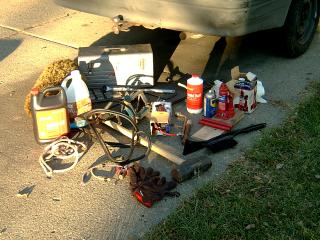
|
|
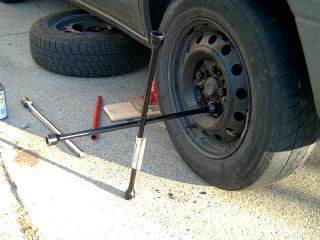 The tire iron that came with the car is inadequate. When
a garage mechanic puts your tire on, they do it with an air
gun that torques the nut very tightly. The tire iron is
too short to allow anyone to get a nut off the car.
It's nearly useless. At one point, my policy was to remove
any tire that I hadn't put on the car and put it back on with
this under-sized tire iron. However, this doesn't solve
enough of the problems, and requires diligence. If you
really examine yourself, you'll discover that you don't have
the discipline to make anything work 100% of the time when there
isn't anyone breathing down your neck checking your work and
reminding you to do it. Set yourself up for success.
One can get a bigger tire iron, if one
looks long enough. There are some big cross style tire irons
that work. They have four different sizes, and fit most
cars. Don't get a small cross - that doesn't help much.
What really works is a breaker bar. But even a good one
does not solve all problems.
Go to
Sears and get Craftsman
tools. Other brands may work, but Craftsman will
work. Get the Craftsmen sockets too.
(And this is from someone who is not brand loyal).
You'll need metric
and English in sizes appropriate for lug nuts. More is better.
Your tool box should have really complete sets anyway.
The tire iron that came with the car is inadequate. When
a garage mechanic puts your tire on, they do it with an air
gun that torques the nut very tightly. The tire iron is
too short to allow anyone to get a nut off the car.
It's nearly useless. At one point, my policy was to remove
any tire that I hadn't put on the car and put it back on with
this under-sized tire iron. However, this doesn't solve
enough of the problems, and requires diligence. If you
really examine yourself, you'll discover that you don't have
the discipline to make anything work 100% of the time when there
isn't anyone breathing down your neck checking your work and
reminding you to do it. Set yourself up for success.
One can get a bigger tire iron, if one
looks long enough. There are some big cross style tire irons
that work. They have four different sizes, and fit most
cars. Don't get a small cross - that doesn't help much.
What really works is a breaker bar. But even a good one
does not solve all problems.
Go to
Sears and get Craftsman
tools. Other brands may work, but Craftsman will
work. Get the Craftsmen sockets too.
(And this is from someone who is not brand loyal).
You'll need metric
and English in sizes appropriate for lug nuts. More is better.
Your tool box should have really complete sets anyway.
The jack that came with your car is probably a scissor jack. I find that a hydraulic jack is so much easier to use that it's worth getting one. A small one will fit under your car. The one I have can only lift the car it's own height. That was the original incentive to bring wood. The idea is to get the jack snug under the car before lifting it. As a side benefit, wood can make a jack stable even on sand.
Originally, the kit included an electric air pump. They get power from your car via the cigarette lighter - the standard interface for power on cars. It takes about ten minutes to inflate a tire that's dead due to a slow leak. You hook it up and wait. There are two problems. One is that the cheap ones don't last very long. Even the expensive ones need to be replaced every five to eight years. They tend to break while you are using them in an emergency, at night, in the rain. That's just Murphy's Law. The other problem is that they depend on other parts of your car working perfectly. If you've had an overnight slow leak, and you pump it up, you may find that your battery, which was adequate to start your car, may not be up to pumping a tire and starting your car. My cigarette lighter doesn't work anymore. A foot pump also takes about ten minutes to pump up the tire from nothing. But, they don't last very long either. I've been through three lately. Due to design defects, they're good for about five to ten full tire fills. So now I have a stand up bicycle pump. They're also cheap and last fifteen years. The foot pumps are not as hard on your back - so you could just get two of them.
See above for a lecture on why you need a real tire. Personally, I would toss the donut the moment I take ownership of the car. And if the car doesn't have a big enough wheel well for a real spare tire, don't buy it.
It is hoped that jumper cables, break fluid, engine oil, transmission fluid, penetrating oil, windshield wiper fluid, rags, soap, Paper Towels, tool box with tools 1 gallon Anti Freeze, pre-mixed would all have some obvious use. 10w30 oil will work all year. If one switches between 10w30 and 10w40, one can forget which is which. Use it on your bicycle chain. Naturally, you only need transmission fluid if you car needs it. When your car overheats, having something to put back into your radiator can be a wonderful thing. With most cars, you really have to wait 15 or 20 minutes before putting water in - it will just over boil in your face.
The rug is really quite important. Mine is an old shag rug remnant. Roll it out under the car and slide under to look. You'll need the flash light. Since batteries die when you aren't looking, I've taken to bringing mine around in my pocket. It uses a single AAA battery. But for working on the car, I have a flash light that straps to my forehead. It's brighter - using 3 AAA batteries, and has LED lamps. I use these things often enough to justify rechargeable batteries. But that's another topic of discussion.
My 1984 Saab has a manual transmission. It has an oil reservoir for the manual transmission, and it takes the same kind of oil that is used for the engine. This is highly unusual. An oil change place once drained my transmission and then attempted to stuff 4 quarts of oil into my engine. It cost me a transmission. When cruising down the highway at 70 mph (110 kph) and both front wheels lock up hard (front wheel drive) it can be challenging to steer the car into a break down lane. I change my own oil now. It's cheaper, faster, and it gets done right.Most manual transmissions do not have any special fluid.
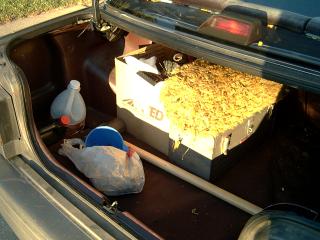 My 17 year old Mazda consumes
enough oil that I buy it by the gallon. (To be fair, it does
get another 35,000 miles (55,000 km) each year and has
well over a quarter million miles (400,000 km)). I use a funnel.
Since doing this, I haven't spilled a drop.
The quart containers require technique to keep
them from spilling, and it's much easier to just use a funnel.
Use a grocery store plastic bag to store the funnel when not
in use to keep your trunk oil free.
My 17 year old Mazda consumes
enough oil that I buy it by the gallon. (To be fair, it does
get another 35,000 miles (55,000 km) each year and has
well over a quarter million miles (400,000 km)). I use a funnel.
Since doing this, I haven't spilled a drop.
The quart containers require technique to keep
them from spilling, and it's much easier to just use a funnel.
Use a grocery store plastic bag to store the funnel when not
in use to keep your trunk oil free.
I haven't yet found a siphon that actually works. Not only does the pump itself fail, but the pump is attached to a hose with seals that leak. Some cars have what must be an anti-theft feature: a metal flap that pinches siphon hoses. That means even if you have a siphon, you can't lend some of your gas to your stranded neighbor. So, I'm looking for a siphon that has a hose strong enough to withstand the anti-theft feature. I really don't want to carry a can full of gas in my trunk.
For a list of the ways that technology has failed to improve our lives, please press "1".